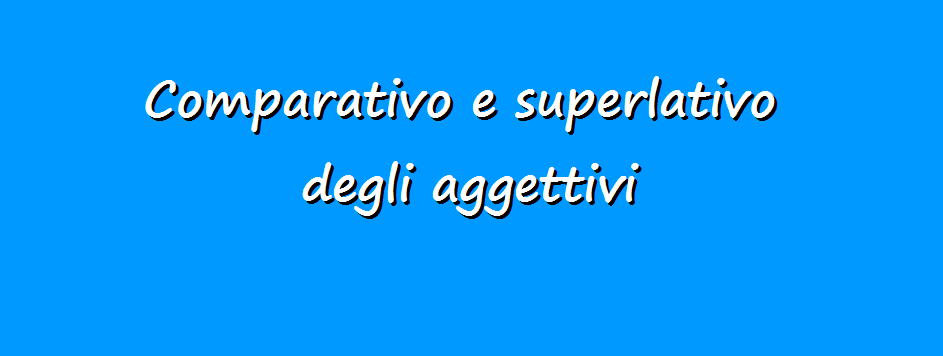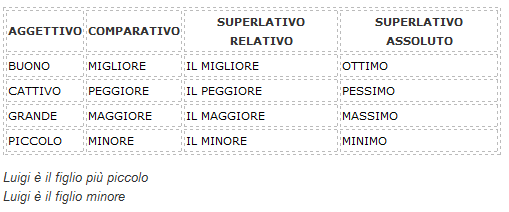
The Comparative form of adjectives in Italian
When someone’s (or something’s) property or quality is compared to the same property or quality belonging to someone (or something) else - or when two properties or qualities belonging to the same subject - are compared, we use the comparative form of adjectives:

(Elena is younger than Marta; Sandra is more beautiful than intelligent)
Comparative of majority
When the subject being referred to has a certain quality in a higher degree than another subject, we use a form called “comparative of majority”:
![]()
Mauro is more studious than Giovanni
As you can see from the examples, the comparative of majority is formed with:
PIÙ + adjective + DI / CHE + second part of the comparison
The second part of the comparison is preceded by DI if:
- it is a noun or a pronoun

- it is an adverb:

The second part of the comparison is preceded by CHE if:
- It is an adjective

- it is preceded by a preposition

- it is a verb

Comparative of minority
When the subject being compared has a certain quality in a lesser degree than in another subject, then we use a form called “comparative of minority”.
![]()
Mauro is less studious than Giovanni
The comparative of minority is formed as follows:
MENO + adjective + DI / CHE + second term of comparison
As for the choice between di and che, the rules seen above for the comparative of majority apply:
![]()
Comparative of equality
When the two parts of the comparison present a certain quality to the same degree, we use a form called “comparative of equality”:
![]()
Driving a car is as fun as riding a bike
The comparative of equality is formed as follows:
TANTO + adjective + QUANTO / COME + second part of the comparison
Quanto and come are interchangeable. It’s up to you which one to use:
![]()
The superlative form of adjectives in Italian
We use the superlative form of an adjective in Italian when we want to express the fact that somebody possesses a certain quality to the maximum extent. The superlative can be either relative or absolute. Let’s look at the difference between the two.
The relative superlative
The relative superlative states that someone or something has a certain quality to the maximum extent within a certain group of people or things.
![]()
Sicily is the most beautiful among Italian islands
Finland is the greenst of all the countries
As you can see from the examples above, the relative superlative can be formed in two ways:
Determinate article + Più / Meno + adjective + Di / Tra / Fra + Noun, or
Determinate article + Noun + Più / Meno + adjective
![]()
The absolute superlative
We use the absolute superlative form to state that someone (or something) has a certain quality to the highest degree, without any term of comparison: it is, in fact, absolute!
![]()
(The) Italian (language) is very known
Sicily is very beautiful
As you can see from the examples above, the absolute superlative is formed by adding the suffix -ISSIMO to the adjective (after removing the last letter of the adjective). There are also other ways to make an adjective a superlative:
- Using an adverb (molto, davvero, realmente…) before an adjective
- Repeating the same adjective twice (only in colloquial, informal language)
- Adding a prefix (arci-, iper-, extra-…) before the adjective

Comparative and superlative forms of some important adjectives
The following adjectives have two forms of the comparative and superlative:
- a regular form which follows the same rules seen above
- an irregular form, which you can see in the following table

Adjectives without any comparative or superlative form
For some adjectives, it is not possible to form a comparative or superlative form, simply because the quality that they express cannot be modulated in terms of intensity. The main adjectives of this kind are:
- Geographic or ethnic adjectives
- Adjectives whose meaning has been altered by a suffix, such as -etto, -occio, -ino, -ello:
- Adjectives which already indicate a quality possessed in an extreme way
Examples:

On this topic you can also consult the following pages:
Exercises on the comparative and superlative
A text about going shopping (with examples)
A song “Abbronzatissima” with many superlatives.
This was very helpful. Grazie